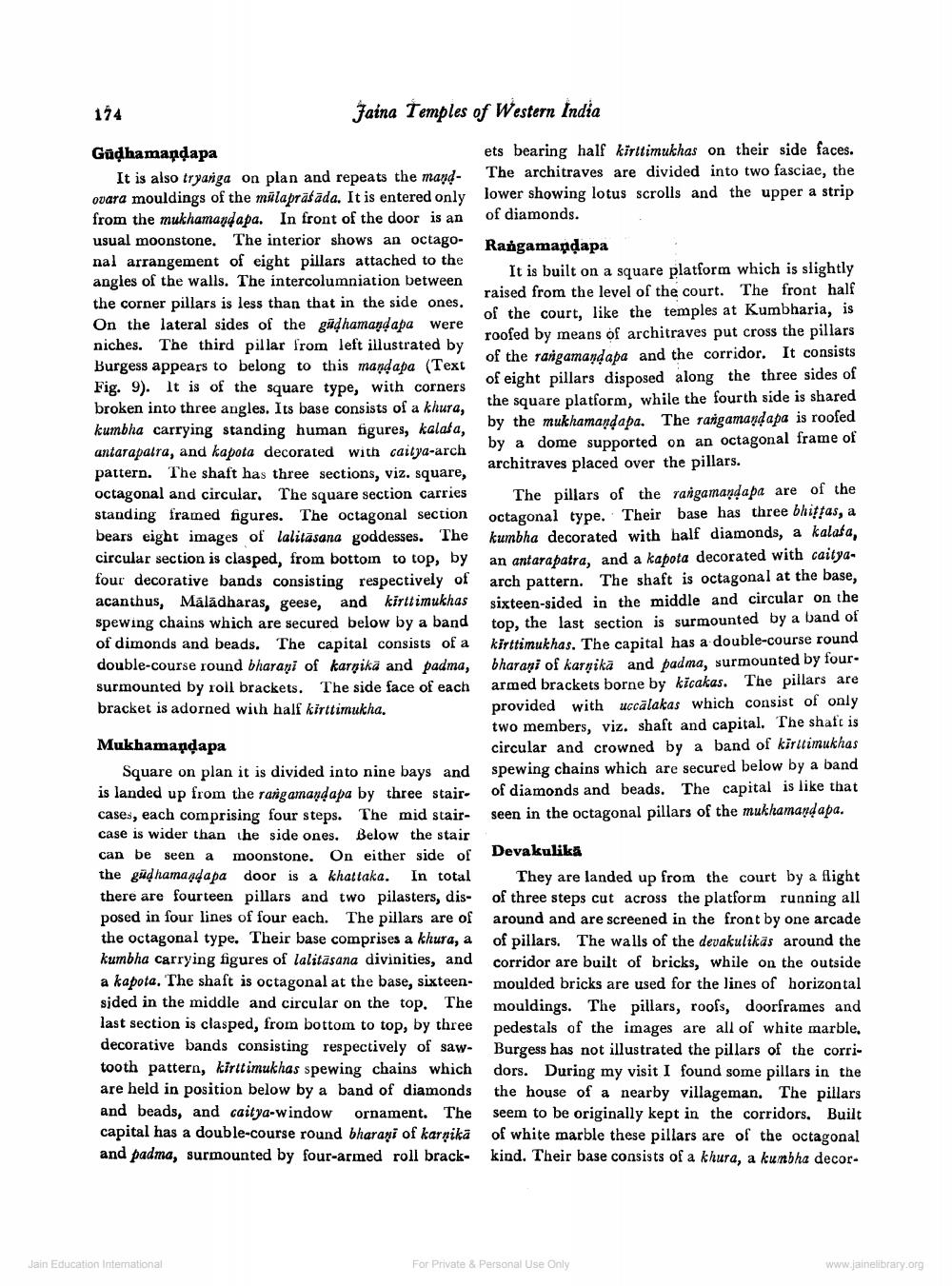________________
174
Faina Temples of Western India
Güdhamapdapa
ets bearing half kiritimukhas on their side faces. It is also tryanga on plan and repeats the mand
The architraves are divided into two fasciae, the ovara mouldings of the milaprašāda. It is entered only lower showing lotus scrolls and the upper a strip from the mukhamandapa. In front of the door is an of diamonds. usual moonstone. The interior shows an octagonal arrangement of eight pillars attached to the
It is built on a square platform which is slightly angles of the walls. The intercolumniation between the corner pillars is less than that in the side ones.
raised from the level of the court. The front half
of the court, like the temples at Kumbharia, is On the lateral sides of the gūdhamand apa were niches. The third pillar from
roofed by means of architraves put cross the pillars
left illustrated by Burgess appears to belong to this mandapa (Text
of the rarigamaņdapa and the corridor. It consists Fig. 9). It is of the square type, with corners
of eight pillars disposed along the three sides of broken into three angles. Its base consists of a khura,
the square platform, while the fourth side is shared kumbha carrying standing human figures, kalata,
by the mukhamandapa. The rangamaydapa is roofed antarapalra, and kapota decorated with caitya-arch
by a dome supported on an octagonal frame of pattern. The shaft has three sections, viz. square,
architraves placed over the pillars. octagonal and circular. The square section carries The pillars of the rangamandapa are of the standing framed figures. The octagonal section octagonal type. Their base has three bhitas, a bears eight images of lalitasana goddesses. The kumbha decorated with half diamonds, a kalasa, circular section is clasped, from bottom to top, by an antarapatra, and a kapota decorated with caitya. four decorative bands consisting respectively of arch pattern. The shaft is octagonal at the base, acanthus, Mälädbaras, geese, and kirttimukhas sixteen-sided in the middle and circular on the spewing chains which are secured below by a band top, the last section is surmounted by a band of of dimonds and beads. The capital consists of a kirttimukhas. The capital has a double-course round double-course round bharani of karyika and padma, bharani of karnika and padma, surmounted by lour surmounted by roll brackets. The side face of each armed brackets borne by kicakas. The pillars are bracket is adorned with half kirttimukha.
provided with uccalakas which consist of only
two members, viz. shaft and capital. The shaft is Mukhamandapa
circular and crowned by a band of kiritimukhas Square on plan it is divided into nine bays and spewing chains which are secured below by a band is landed up from the rangamandapa by three stair- of diamonds and beads. The capital is like that cases, each comprising four steps. The mid stair- seen in the octagonal pillars of the mukhamandapa. case is wider than the side ones. Below the stair can be seen a moonstone. On either side of the gūdhamaqdapa door is a khattaka. In total They are landed up from the court by a flight there are fourteen pillars and two pilasters, dis- of three steps cut across the platform running all posed in four lines of four each. The pillars are of around and are screened in the front by one arcade the octagonal type. Their base comprises a khura, a of pillars. The walls of the devakulikās around the kumbha carrying figures of lalitasana divinities, and corridor are built of bricks, while on the outside a kapota, The shaft is octagonal at the base, sixteen- moulded bricks are used for the lines of horizontal sided in the middle and circular on the top. The mouldings. The pillars, roofs, doorfram last section is clasped, from bottom to top, by three pedestals of the images are all of white marble, decorative bands consisting respectively of say- Burgess has not illustrated the pillars of the corritooth pattern, kiritimukhas spewing chains which dors. During my visit I found some pillars in the are held in position below by a band of diamonds the house of a nearby villageman. The pillars and beads, and caitya-window ornament. The seem to be originally kept in the corridors. Built capital has a double-course round bharaṇi of karnika of white marble these pillars are of the octagonal and padma, surmounted by four-armed roll brack- kind. Their base consists of a khura, a kumbha decor
Jain Education International
For Private & Personal Use Only
www.jainelibrary.org




